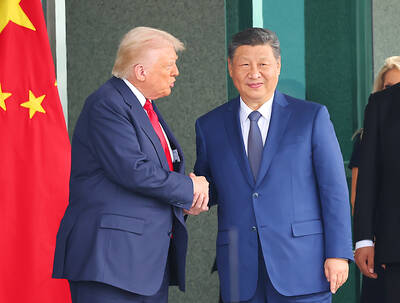Russian President Vladimir Putin on Thursday said that the country’s natural gas must be paid for with rubles, a demand apparently intended to help bolster the Russian currency, but one that European leaders say they will not comply with because it violates the terms of contracts and sanctions.
Putin said that Russia was to start accepting ruble payments from yesterday and gas supplies would be cut off if buyers do not agree to the new conditions, including opening ruble accounts in Russian banks, from which the gas payments would be made.
“If these payments are not made, we will consider it a failure of the buyer to fulfill its obligations, with all the ensuing consequences,” Putin said.
European leaders said that they would continue to pay for natural gas in euros and US dollars, and want to see the fine print of how the Kremlin will implement its decree.
It came a day after the leaders of Italy and Germany said they received assurances from Putin about gas supplies.
Putin last week said that countries deemed “unfriendly” for imposing sanctions on Russia over its war in Ukraine must pay for natural gas only in the Russian currency.
His proposal has caused natural gas prices to gyrate and raised fears it could be a prelude to an interruption of supplies to Europe, which is heavily dependent on Russian natural gas and would struggle with a sudden cutoff.
At the same time, Russia depends on oil and gas sales for much of its government revenue at a time its economy is under severe stress from Western sanctions.
Putin’s demand appeared to be part of Russia’s efforts to boost the ruble after the currency plunged under Western sanctions. After dropping as low as 143 rubles to the US dollar early last month, on Thursday it took 82 rubles to buy a dollar, around the same level as the day Russia launched its invasion.
Economists say that switching the gas payments to rubles would do little to support the Russian currency, as gas exporter Gazprom has to sell 80 percent of its foreign currency earnings for rubles anyway.
The White House on Thursday said that the ruble is no longer a reliable measure of Russia’s economy because it is being artificially propped up.
Analysts at Evercore ISI said that Putin’s primary motive seems to be “to prove he can bend EU leaders to his will.”
Even if Russia is able to force the EU to pay for gas in rubles, the European countries could retaliate by imposing more tariffs on Russian oil imports or banning them outright, the analysts said.
While Russia could eventually sell the oil, the price would likely be at a steep discount, they said.
The decree Putin signed and a Russian News and Information Agency report say that a designated bank would open two accounts for each buyer, one in foreign currency and one in rubles.
Buyers would pay in foreign currency and authorize the bank to sell it for rubles on Moscow’s currency exchange.
The rubles would then be placed in the second account, where the gas is formally purchased.

RUN IT BACK: A succesful first project working with hyperscalers to design chips encouraged MediaTek to start a second project, aiming to hit stride in 2028 MediaTek Inc (聯發科), the world’s biggest smartphone chip supplier, yesterday said it is engaging a second hyperscaler to help design artificial intelligence (AI) accelerators used in data centers following a similar project expected to generate revenue streams soon. The first AI accelerator project is to bring in US$1 billion revenue next year and several billion US dollars more in 2027, MediaTek chief executive officer Rick Tsai (蔡力行) told a virtual investor conference yesterday. The second AI accelerator project is expected to contribute to revenue beginning in 2028, Tsai said. MediaTek yesterday raised its revenue forecast for the global AI accelerator used

TEMPORARY TRUCE: China has made concessions to ease rare earth trade controls, among others, while Washington holds fire on a 100% tariff on all Chinese goods China is effectively suspending implementation of additional export controls on rare earth metals and terminating investigations targeting US companies in the semiconductor supply chain, the White House announced. The White House on Saturday issued a fact sheet outlining some details of the trade pact agreed to earlier in the week by US President Donald Trump and Chinese President Xi Jinping (習近平) that aimed to ease tensions between the world’s two largest economies. Under the deal, China is to issue general licenses valid for exports of rare earths, gallium, germanium, antimony and graphite “for the benefit of US end users and their suppliers

Dutch chipmaker Nexperia BV’s China unit yesterday said that it had established sufficient inventories of finished goods and works-in-progress, and that its supply chain remained secure and stable after its parent halted wafer supplies. The Dutch company suspended supplies of wafers to its Chinese assembly plant a week ago, calling it “a direct consequence of the local management’s recent failure to comply with the agreed contractual payment terms,” Reuters reported on Friday last week. Its China unit called Nexperia’s suspension “unilateral” and “extremely irresponsible,” adding that the Dutch parent’s claim about contractual payment was “misleading and highly deceptive,” according to a statement

Artificial intelligence (AI) giant Nvidia Corp’s most advanced chips would be reserved for US companies and kept out of China and other countries, US President Donald Trump said. During an interview that aired on Sunday on CBS’ 60 Minutes program and in comments to reporters aboard Air Force One, Trump said only US customers should have access to the top-end Blackwell chips offered by Nvidia, the world’s most valuable company by market capitalization. “The most advanced, we will not let anybody have them other than the United States,” he told CBS, echoing remarks made earlier to reporters as he returned to Washington